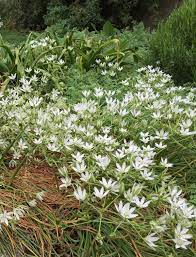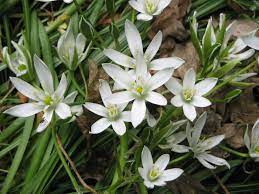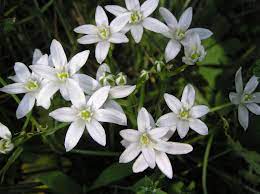Ornithogalum umbellatum, commonly known as Star-of-Bethlehem, is a delicate and charming perennial herbaceous plant belonging to the Asparagaceae family. This native European wildflower is characterized by its graceful appearance, featuring clusters of small, star-shaped white flowers that seem to glow against a backdrop of lush green foliage.
Beyond its ornamental appeal, Ornithogalum umbellatum has been historically recognized for its potential medicinal properties.
Star of Bethlehem has a long history of cultural significance. Its name is derived from the biblical reference to the Star of Bethlehem, which was said to have led the three wise men to the birthplace of Jesus. In various cultures, this plant has symbolized purity, hope, and rebirth.
Ornithogalum umbellatum typically grows to a height of 10-30 cm (4-12 inches). Its slender, linear leaves form a basal rosette, and in spring, it produces a delicate, umbrella-like cluster of small, white, six-petal flowers. Each flower has a green stripe running down the center of its petal, enhancing its star-like appearance.
Below ground, Star of Bethlehem forms small, bulbous structures called corms. These corms serve as storage organs and allow the plant to survive and multiply, even in adverse conditions.
Ornithogalum umbellatum is a hardy plant that can thrive in a variety of environments. It prefers well-drained soil and can tolerate both full sun and partial shade. This adaptability makes it a common sight in gardens, meadows, woodland edges, and disturbed areas. It has a propensity to naturalize and spread rapidly, making it a potential nuisance in some regions.
The flowering period for Star of Bethlehem typically occurs in the spring, from April to June, depending on the local climate. During this time, the plant produces clusters of elegant white flowers, creating a charming display.
Star-of-Bethlehem is commonly found in open woodlands, meadows, and grassy areas across Europe. It prefers well-drained soils and can thrive in both full sun and partial shade.
Cultivation and Harvesting of Star-of-Bethlehem Medicinal Plant
Ornithogalum umbellatum is relatively easy to cultivate, making it a favorite choice for both novice and experienced gardeners. Here are some tips for growing and caring for this plant:
1. Sunlight: Plant the bulbs in a location that receives partial to full sunlight. They thrive in well-draining soil.
2. Planting: Plant the bulbs in the fall at a depth of about 2 to 4 inches (5 to 10 cm) and space them approximately 3 to 6 inches (8 to 15 cm) apart.
3. Watering: Keep the soil evenly moist during the growing season but avoid waterlogged conditions.
4. Maintenance: After flowering, allow the foliage to die back naturally, as this helps replenish the bulb for the next season. You can divide the bulbs every few years to prevent overcrowding.
The Medicinal Health Benefits of Star-of-Bethlehem (Ornithogalum umbellatum)

Ornithogalum umbellatum has been traditionally used in herbal medicine for its potential health benefits. While more research is needed to fully understand its effects, it is believed to offer several health benefits:
1. Digestive Aid: This plant has been used as a digestive aid in traditional medicine. It help soothe digestive discomfort and promote healthy digestion.
2. Respiratory Health: Ornithogalum umbellatum has been used to address respiratory issues such as coughs and congestion. It may help relieve symptoms of respiratory conditions.
3. Anti-Inflammatory Properties: Star-of-Bethlehem may contain compounds with anti-inflammatory properties, which can help reduce inflammation in the body and alleviate symptoms associated with conditions like arthritis.
4. Diuretic Effects: It has been used as a mild diuretic, potentially aiding in the elimination of excess fluids and waste from the body.
5. Homeopathic Medicine: In homeopathy, extracts from Ornithogalum umbellatum have been used to treat various conditions, including emotional distress, sleep disorders, and digestive issues. Homeopathic remedies are highly diluted substances, and their efficacy is a subject of debate within the medical community.
6. Skin Conditions: Some traditional uses of Ornithogalum umbellatum include applying poultices or creams made from the plant to treat skin conditions such as burns, wounds, and rashes. However, scientific evidence supporting these claims is lacking.
Read Also: 7 Medicinal Health Benefits of Daffodils (Narcissus Plant)
The Methods of Usage to Achieve the Provided Health Benefits of Star-of-Bethlehem (Ornithogalum umbellatum)
1. Herbal Infusions: One common method of using Ornithogalum umbellatum is to prepare herbal infusions by steeping dried or fresh parts of the plant, such as leaves or bulbs, in hot water. This infusion can be consumed in moderation.
2. Tinctures: Another way to extract the plant’s potential benefits is by making tinctures using alcohol or glycerin. These tinctures can be taken in accordance with recommended dosages.
3. Topical Application: Some traditional remedies involve using a poultice or ointment made from the crushed plant parts for relieving skin conditions or joint pain.Be cautious when using it topically, as it may cause skin irritation in some
Read Also: Pests of Stored Products and Damages Caused
The Side Effects of Using Star-of-Bethlehem Medicinal Plant
While Ornithogalum umbellatum may offer health benefits, it is important to be aware of potential side effects and exercise caution:
1. Skin Sensitivity: Some individuals may experience skin irritation or allergic reactions when handling the plant. so it is advisable to wear gloves when working with it.
2. Skin Irritation: Handling or coming into contact with the plant’s sap or leaves may cause skin irritation, including redness, itching, and rash. Some individuals may be more sensitive to the plant’s compounds and experience more severe skin reactions. It is advisable to wear gloves when working with this plant.
3. Eye Irritation: If the sap or plant juices come into contact with the eyes, it can cause irritation, redness, and discomfort. It’s important to wash your eyes thoroughly with water if this happens and seek medical attention if irritation persists.
4. Gastrointestinal Disturbances: Ingesting parts of the plant can potentially lead to stomach upset, nausea, vomiting, and diarrhea. However, the plant is not typically consumed as food.
5. Allergic Reactions: In rare cases, individuals with plant allergies may experience allergic reactions when exposed to Ornithogalum umbellatum. Symptoms may include itching, hives, swelling, and difficulty breathing. Seek immediate medical attention if you experience severe allergic reactions.
5. Photosensitivity: prolonged exposure to the plant’s sap or juices on the skin, followed by sunlight exposure, may increase the risk of photodermatitis or photosensitivity reactions. This can lead to skin inflammation, redness, and blistering.
6. Toxicity: The plant contains alkaloids, saponins, and other toxic compounds that can be harmful if ingested. Ingesting even small amounts of the plant can lead to symptoms of poisoning, including nausea, vomiting, diarrhea, abdominal pain, and in severe cases, cardiac and neurological effects.
7. Cardiac Effects: Ingesting larger quantities of the plant may result in cardiac effects, including irregular heartbeats or other cardiovascular symptoms. Severe poisoning can be life-threatening.
8. Neurological Effects: In rare cases, ingestion of Ornithogalum umbellatum may lead to neurological symptoms such as confusion, dizziness, or seizures.
Precautions and Recommendations in Using Star-of-Bethlehem Medicinal Plant

1. Wear Gloves: When handling Ornithogalum umbellatum, it is a good idea to wear gloves to prevent skin contact with any potentially toxic sap or plant parts.
2. Keep Out of Reach: If you have small children or pets, consider planting Ornithogalum umbellatum in an area that is not easily accessible to them. This will reduce the risk of accidental ingestion.
3. Educate Yourself: Learn to identify Ornithogalum umbellatum so that you can recognize it in your garden and take appropriate precautions.
4. Label Plants: If you have Ornithogalum umbellatum in your garden, consider labeling it as toxic to warn others about its potential dangers.
5. Don’t Ingest: Avoid consuming any part of the plant, as ingestion can lead to symptoms such as nausea, vomiting, diarrhea, and, in severe cases, more serious health issues.
6. Practice Good Hygiene: After handling the plant or working in the garden, wash your hands thoroughly to remove any plant residue.
7. Monitor Pets: If you have pets, keep an eye on them when they are in the garden to ensure they do not nibble on this or other potentially toxic plants.
8. Consider Removing It: If you have concerns about the safety of Ornithogalum umbellatum in your garden, you may want to consider removing it and replacing it with non-toxic plants.
9. Contact Poison Control: If you or someone else ingests any part of the plant and experiences symptoms of poisoning, contact your local poison control center or seek medical attention immediately.
10. Avoid Ingestion: All parts of the plant, especially the bulbs, contain toxic alkaloids. Ingesting any part of the plant can lead to symptoms such as nausea, vomiting, diarrhea, and even more severe health issues. Keep this plant away from children and pets.
11. Proper Disposal: If you need to remove or dispose of the plant, do so carefully. Wear gloves, and avoid touching your face while handling the plant. Place the removed plant material in a sealed bag or container before disposing of it in the trash. Do not compost it.
12. Keep Away from Edible Plants: If you’re growing Ornithogalum umbellatum in your garden or yard, make sure it’s not in close proximity to edible plants or vegetables to prevent accidental ingestion or contamination.
13. Pregnancy and Nursing: Pregnant and nursing individuals should avoid using this plant due to its potential risks.
14. Consult a Healthcare Professional: Before using this plant for medicinal purposes, consult with a qualified healthcare provider or herbalist to determine the appropriate dosage and method of use.
FAQs About Star-of-Bethlehem Medicinal Plant
1. What does Ornithogalum umbellatum look like?
Ornithogalum umbellatum is a small herbaceous plant that typically grows to a height of 15-30 cm (6-12 inches). It has narrow, lance-shaped leaves and produces small, star-shaped white flowers with six petals arranged in a loose cluster (umbel) at the top of a stem.
2. Is Ornithogalum umbellatum invasive?
Yes, Ornithogalum umbellatum is considered invasive in many regions. It can spread rapidly and outcompete native plants, making it a nuisance in gardens and natural areas.
3. When does Ornithogalum umbellatum bloom?
Star of Bethlehem typically blooms in the spring, usually from April to June, depending on the local climate and growing conditions.
4. Is Ornithogalum umbellatum toxic?
Yes, Ornithogalum umbellatum is toxic if ingested, and all parts of the plant contain toxic compounds. It can be harmful to humans, pets, and livestock if consumed. Avoid handling the plant without gloves and keep it away from children and animals.
5. Can I grow Ornithogalum umbellatum in my garden?
While some people appreciate the beauty of the Star of Bethlehem’s flowers, it is important to be aware of its invasive nature. If you choose to grow it in your garden, consider containing it in pots or planters to prevent it from spreading into natural areas.
6. What are some similar-looking plants to Ornithogalum umbellatum?
Plants that may be confused with Ornithogalum umbellatum include other small white-flowering spring bulbs, such as Allium ursinum (wild garlic), Anemone nemorosa (wood anemone), and Galanthus nivalis (snowdrops). It is important to be able to distinguish between these species, especially if you’re concerned about invasive plants in your garden.
7. Can Ornithogalum umbellatum be used for medicinal purposes?
Traditionally, some cultures used parts of Ornithogalum umbellatum for medicinal purposes, but it’s not recommended due to its toxicity. There are safer alternatives for herbal and medicinal uses.
8. Can Ornithogalum umbellatum be used for medicinal purposes?
Historically, some cultures have used parts of Ornithogalum umbellatum for medicinal purposes, but it is not recommended today due to its toxicity. There are safer alternatives for herbal remedies.
9. Are there any pests or diseases that affect Ornithogalum umbellatum?
Ornithogalum umbellatum is generally not very susceptible to pests or diseases. However, it can sometimes be affected by aphids or snails. Keeping the area clean and practicing good garden hygiene can help prevent these issues.
10. Can Ornithogalum umbellatum be grown indoors?
While Ornithogalum umbellatum is primarily grown outdoors, you can grow it in pots or containers indoors as long as you provide it with the right conditions. Make sure it receives sufficient sunlight and well-draining soil.
Is Ornithogalum umbellatum the same as wild garlic or spring onion?
No, Ornithogalum umbellatum is not the same as wild garlic or spring onion. While they may look somewhat similar, they are different plants with distinct characteristics. Wild garlic (Allium ursinum) and spring onion (Allium fistulosum) are members of the onion family (Alliaceae) and are edible, while Ornithogalum umbellatum is toxic.
Can I use Ornithogalum umbellatum in floral arrangements?
Ornithogalum umbellatum’s delicate white flowers with green stripes can be used in floral arrangements to add a touch of elegance. However, it is essential to handle them with care due to their toxicity and to avoid contact with skin or ingestion.
Read Also: Relationship Marketing Process and Approaches to the Study of Marketing

